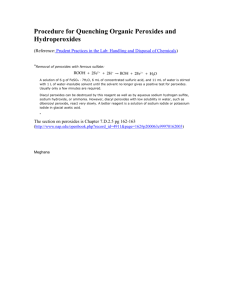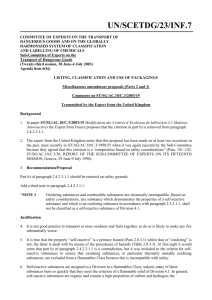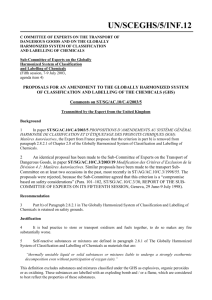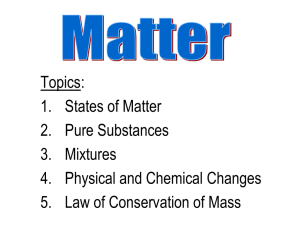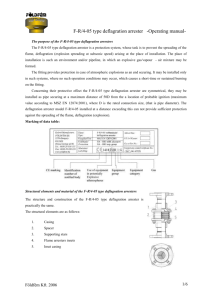United Nations
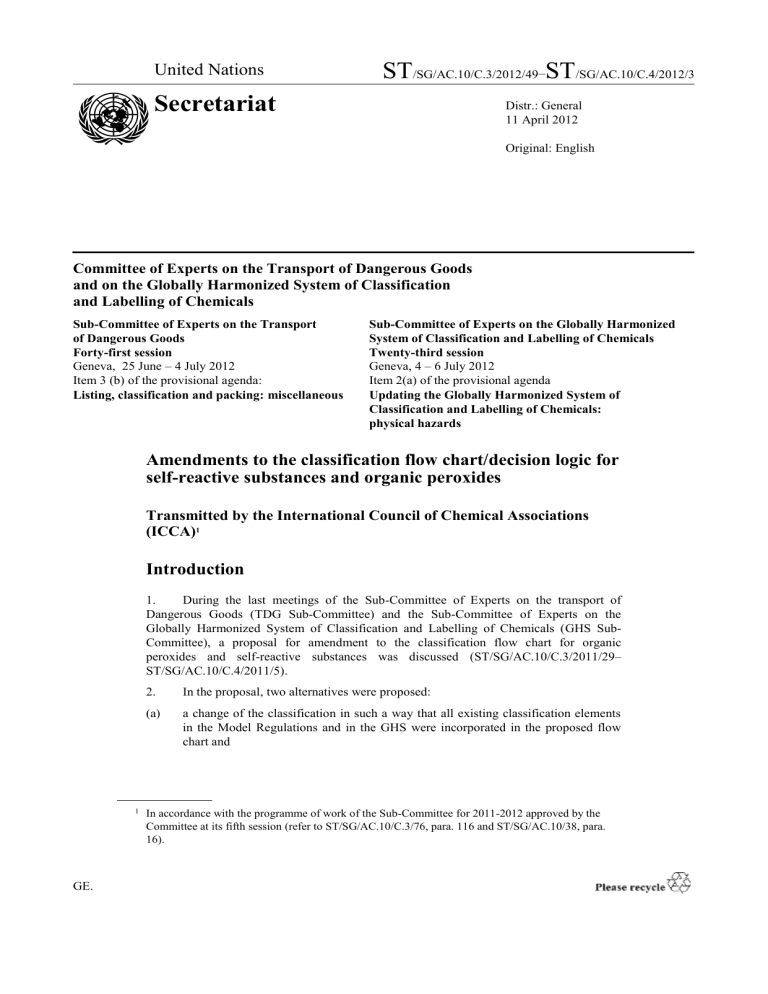
United Nations
Secretariat
ST
/SG/AC.10/C.3/2012/49−
ST
/SG/AC.10/C.4/2012/3
Distr.: General
11 April 2012
Original: English
Committee of Experts on the Transport of Dangerous Goods and on the Globally Harmonized System of Classification and Labelling of Chemicals
Sub-Committee of Experts on the Transport of Dangerous Goods
Forty-first session
Geneva, 25 June – 4 July 2012
Item 3 (b) of the provisional agenda:
Listing, classification and packing: miscellaneous
Sub-Committee of Experts on the Globally Harmonized
System of Classification and Labelling of Chemicals
Twenty-third session
Geneva, 4 – 6 July 2012
Item 2(a) of the provisional agenda
Updating the Globally Harmonized System of
Classification and Labelling of Chemicals: physical hazards
Amendments to the classification flow chart/decision logic for self-reactive substances and organic peroxides
Transmitted by the International Council of Chemical Associations
(ICCA) 1
Introduction
1. During the last meetings of the Sub-Committee of Experts on the transport of
Dangerous Goods (TDG Sub-Committee) and the Sub-Committee of Experts on the
Globally Harmonized System of Classification and Labelling of Chemicals (GHS Sub-
Committee), a proposal for amendment to the classification flow chart for organic peroxides and self-reactive substances was discussed (ST/SG/AC.10/C.3/2011/29–
ST/SG/AC.10/C.4/2011/5).
2. In the proposal, two alternatives were proposed:
(a) a change of the classification in such a way that all existing classification elements in the Model Regulations and in the GHS were incorporated in the proposed flow chart and
1 In accordance with the programme of work of the Sub-Committee for 2011-2012 approved by the
Committee at its fifth session (refer to ST/SG/AC.10/C.3/76, para. 116 and ST/SG/AC.10/38, para.
16).
GE.
ST/SG/AC.10/C.3/2012/49
ST/SG/AC.10/C.4/2012/3
(b) in addition to (a), the classification of liquid organic peroxides/self-reactive substances Type G, as Type F as soon as they are transported or handled in
Intermediate Bulk Containers (IBC) or tanks.
3. There was a long discussion on the last alternative proposal. The classification of solids in larger quantities (IBCs and tanks) was discussed as well as a number of other complicated issues that are already under discussion for many years in expert groups like the Working Group on Energetic and Oxidizing Substances (EOS) of the International
Group of Experts on the Explosion Risks of Unstable Substances (IGUS).
4. It was never the aim of ICCA to resolve all these issues in the proposal. Therefore
ICCA withdrew the complicated proposal (i.e. the one that included changes in classification principles) and promised to come back with a new proposal that would address only the aspects of classification elements that already exist in the current version of the Model Regulations and the GHS.
I. Backgrounds to the proposal
5. It was observed that various issues that determine the classification of substances or mixtures are addressed in the text of the Model Regulations and the GHS, but are not incorporated in the flow chart. These aspects can easily be overlooked by users not so familiar with the detailed text. As they are part of the classification procedure, it is more appropriate to include them in the classification flow charts for both self-reactive substances and organic peroxides. These flow charts are identical.
6. It was agreed during the last IGUS-EOS meeting that ICCA would prepare a proposal to both subcommittees (TDG and GHS).
7. The following aspects are addressed in the text of the Model Regulations and the
GHS but are not incorporated in the classification flow charts:
(a) no type G classification possible if the Self-accelerating decomposition temperature
(SADT) of the substance is < 60 ºC in a 50 kg packaging (see Model regulations paragraphs 2.4.2.3.3.2 (g) and 2.5.3.3.2 (g) and GHS paragraphs 2.8.2.2 (g) and
2.15.2.2 (g))
(b) no type G classification possible when a diluent is used with a boiling point < 150 ºC (see Model regulations paragraphs 2.4.2.3.3.2 (g) and 2.5.3.3.2 (g) and GHS paragraphs 2.8.2.2 (g) and 2.15.2.2 (g))
8. In the proposed amended flow chart these two aspects are addressed in the new boxes 14 and 15 respectively. The introduction of these boxes will not lead to a change in the existing classification principles.
II. Proposals
9. Based on the background given in section II of this document (no change in classification principles) the following is proposed (changes are shown in grey shading):
2
ST/SG/AC.10/C.3/2012/49
ST/SG/AC.10/C.4/2012/3
(a) In the Chapters 2.4 and 2.5 of the Model Regulations replace Figures
2.4.1 and 2.5.1 by the following:
Figure 2.4.1: FLOW CHART SCHEME FOR SELF-REACTIVE SUBSTANCES
Figure 2.5.1: FLOW CHART SCHEME FOR ORGANIC PEROXIDES
ORGANIC PEROXIDE/SELF-REACTIVE SUBSTANCE
Box 1
Box 2
1.1 Yes
Does it propagate a detonation
?
1.2 Partial
1.3 No
2.1 Yes
Can it detonate as packaged for transport
?
2.2 No
Box 3
3.1
Yes, rapidly
Can it propagate a deflagration
?
Box 4
3.2
Yes, slowly
3.3
No
4.1
Yes, rapidly
Can it propagate a deflagration
?
Box 5
4.2
Yes, slowly
4.3
No
Can it propagate
5.1
Yes, rapidly a deflagration
?
5.3 No
6.2
No
5.2 Yes, slowly
Box 7
6.1 Yes
Box 6
Does it deflagrate rapidly in package
?
What is the effect
Box 10
Can it explode as packaged for transport
7.1
Violent of heating it under defined
confinement
?
7.2 Medium
7.3 Low
7.4 No
Box 8
What is the effect
8.1
Violent of heating it under defined
confinement
?
10.2 No
8.2 Medium
8.3 Low
8.4 No
Box 9
What is the effect of heating it under defined
9.1
Violent
confinement
?
9.3 Low
9.4 No
9.2
Medium
?
10.1 Yes
Exit A
NOT ACCEPTED
FOR TRANSPORT
IN THAT
PACKAGING
Exit B
A C C E P T E D F O R
T R A N S P O R T I N
P A C K A G E S O F N O T
M O R E T H A N 2 5 K G
N E T M A S S W I T H
“E X P LO S IV E ”
S U B S I D I A R Y R I S K
L A B E L
Exit C
ACCEPTED FOR
TRANSPORT
IN PACKAGES OF NOT
MORE THAN 50 KG
NET MASS
Exit D
ACCEPTED FOR
TRANSPORT
IN PACKAGES OF NOT
MORE THAN 50 KG
NET MASS go to box 11
3
ST/SG/AC.10/C.3/2012/49
ST/SG/AC.10/C.4/2012/3
Figure 2.4.1: FLOW CHART SCHEME FOR SELF-REACTIVE SUBSTANCES (cont'd) *
Figure 2.5.1: FLOW CHART SCHEME FOR ORGANIC PEROXIDES (cont'd) from box 9
Exit E
Box 11
Is the organic peroxide* to be considered for transport in IBCs or tanks, or for exemption
?
11.2 No
Box 13
11.1 Yes
Box 12
12.1 Not low
What is its explosive power
?
12.3 None
What is the effect of heating it under defined
13.1 Low
confinement
?
13.2 None
12.2 Low
14.1 Yes
Box 14
Is the SADT <60 ºC in a 50 kg package
14.2 No
?
Box 15
Is the substance a solid
15.1 Yes
15.2 No
?
ACCEPTED FOR TRANSPORT IN
PACKAGES OF NOT MORE THAN
400KG/450 LITRES
* Respectively “self-reactive substance”
Exit F
MAY BE
CONSIDERED FOR
TRANSPORT IN IBCS
OR TANKS
16.1 Yes
Box 16
Is a diluent with a boiling point of
< 150 ºC used
16.2 No
?
Exit G
SHALL BE CONSIDERED FOR
EXEMPTION
4
ST/SG/AC.10/C.3/2012/49
ST/SG/AC.10/C.4/2012/3
(b) In Chapters 2.8 and 2.15 of the GHS replace decision logics 2.8 and 2.15 by the following:
Decision logic 2.8 for self-reactive substances and mixtures
Decision logic 2.15 for organic peroxides
SUBSTANCE/MIXTURE
2.1 Yes
Box 2
Test B
Can it detonate as packaged
Box 6
?
6.1 Yes
Test D
Does it deflagrate rapidly in package
?
2.2 No
1.1 Yes
Box 1
Test A
Does it propagate a detonation
?
1.2 Partial
1.3 No
Box 3
Test C
3.1
Yes, rapidly
Can it propagate a deflagration
Box 4
?
Test C
3.2
Yes, slowly
3.3
No
4.1
Yes, rapidly
Can it propagate a deflagration
?
Box 5
Test C
4.2
Yes, slowly
4.3
No
Can it propagate
5.1
Yes, rapidly a deflagration
?
5.3 No
6.2
No
Box 7
5.2 Yes, slowly
Test E
Box 10
Can it explode as packaged
What is the effect
7.1
Violent of heating it under defined
confinement
?
7.2 Medium
7.3 Low
7.4 No
Box 8
Test E
What is the effect of heating it under defined
8.1
Violent
confinement
?
10.2 No
8.2 Medium
8.3 Low
8.4 No
Box 9
Test E
What is the effect of heating it under defined
9.1
Violent
confinement
?
9.3 Low
9.4 No
9.2
Medium
?
10.1 Yes
Type A Type B Type C Type D go to box 11
5
ST/SG/AC.10/C.3/2012/49
ST/SG/AC.10/C.4/2012/3
Decision logic 2.8 for self-reactive substances and mixtures (cont'd)
Decision logic 2.15 for organic peroxides (cont'd) from box 9
Box 11
Packaged in packages of more than 400 kg/450 l or to be considered for exemption
?
11.2 No
Box 13
Test E
What is the effect of heating it under defined
11.1 Yes
Box 12
Test F
12.1 Not low
What is its explosive power
?
12.3 None
13.1 Low
confinement
?
13.2 None
Box 14
12.2 Low Test H
14.1 Yes
Is the SADT <60 ºC in a 50 kg package
?
14.2 No
Box 15
Is the substance a solid
?
15.2 No
15.1 Yes
Box 16
16.1 Yes
Is a diluent with a boiling point of
< 150 ºC used
?
16.2 No
Type E Type F
(Note: the grey shaded wording in boxes 10 and 13 are just corrections.)
Type G
6
ST/SG/AC.10/C.3/2012/49
ST/SG/AC.10/C.4/2012/3
III. Consequential amendments
10. When proposal is adopted, the following flow charts have to be amended accordingly:
• In the Manual of Tests and Criteria the flow chart given in Figure 20.1 (b)
7

